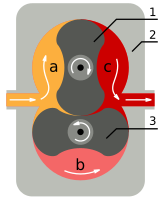
Photo from wikipedia
Understanding the charge transfer dynamics at the interface of metals and semiconductors has received much attention in efficient plasmonic induced photonic devices. Here, we present ultrafast charge transfer dynamics in… Click to show full abstract
Understanding the charge transfer dynamics at the interface of metals and semiconductors has received much attention in efficient plasmonic induced photonic devices. Here, we present ultrafast charge transfer dynamics in Au–ZnO nanocomposite systems by exciting them in interband and intraband levels of Au with pump energies higher (2.48 eV) and lower (1.96 eV) than the threshold energy for interband transition (2.4 eV), using the femtosecond time-resolved pump-probe technique. The spectral responses for both the excitations exhibit different behaviors, and these variations are quantitatively interpreted in terms of pump-induced changes in the dielectric constant of Au. It is found from the temporal dynamics that the electron–phonon component in the Au–ZnO system decays relatively faster (∼3 ps in the multilayer Au–ZnO) than that observed in the Au sample (∼7 ps in Au) for both the pump energies. The transfer of highly energetic hot electrons from Au nanoparticles to ZnO across the Schottky barrier results in an accessible optical response for wide bandgap ZnO in the visible to infrared range via plasmon charge collection. The calculated charge transfer rate in the Au–ZnO system is found to be (>1011 s−1). Our results demonstrate the pump excitation dependent ultrafast plasmon charge behavior in an optically active Au–ZnO system that can be attractive for efficient plasmonic-based hybrid photonic devices.Understanding the charge transfer dynamics at the interface of metals and semiconductors has received much attention in efficient plasmonic induced photonic devices. Here, we present ultrafast charge transfer dynamics in Au–ZnO nanocomposite systems by exciting them in interband and intraband levels of Au with pump energies higher (2.48 eV) and lower (1.96 eV) than the threshold energy for interband transition (2.4 eV), using the femtosecond time-resolved pump-probe technique. The spectral responses for both the excitations exhibit different behaviors, and these variations are quantitatively interpreted in terms of pump-induced changes in the dielectric constant of Au. It is found from the temporal dynamics that the electron–phonon component in the Au–ZnO system decays relatively faster (∼3 ps in the multilayer Au–ZnO) than that observed in the Au sample (∼7 ps in Au) for both the pump energies. The transfer of highly energetic hot electrons from Au nanoparticles to ZnO across the Schottky barrier results...
Journal Title: Journal of Applied Physics
Year Published: 2020
Link to full text (if available)
Share on Social Media: Sign Up to like & get
recommendations!